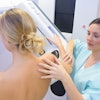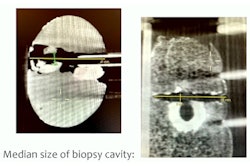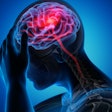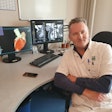
An artificial intelligence (AI) algorithm for breast conebeam CT (CBCT) studies can accurately differentiate between benign and malignant breast lesions, potentially improving the real-world performance of radiologists reading CBCT images, according to a Web-exclusive paper in the August issue of the American Journal of Roentgenology.
Researchers led by Dr. Johannes Uhlig of the University Medical Center Goettingen in Germany trained five different machine-learning techniques to predict malignancy on breast lesions found on breast CBCT. The best method, back propagation neural networks (BPNs), had slightly lower sensitivity than the most experienced radiologist participating in the study, but it was more sensitive than a second radiologist with less breast CBCT experience. What's more, the algorithm produced higher specificity and area under the curve (AUC) than both readers.
"Once breast CBCT is clinically implemented, machine learning techniques could aid radiologists without in-depth experience in breast CBCT in image assessment," they wrote (AJR, August 2018, Vol. 211:2, pp. W123-W131).
While breast CBCT has been shown to provide excellent performance in detecting breast lesions, its diagnostic performance for discriminating between benign and malignant lesions has varied across studies in the literature, according to the authors.
"Some of this variability could be attributable to differences in reader experience with breast CBCT or divergent patient cohorts," they wrote. "Still, the critical question about the true diagnostic performance of breast CBCT remains, especially considering the high breast CBCT radiation dose of up to 16.6 mGy and the possibility of using alternative imaging modalities, such as MRI."
As a result, the researchers sought to investigate the use of machine-learning algorithms in predicting malignant breast CBCT lesions and compare their results with two experienced human readers. They trained and evaluated five different machine-learning techniques -- BPNs, extreme learning machines, support vector machines, and K-nearest neighbors -- on a clinical dataset of 35 patients with BI-RADS density type C and D breasts with 81 suspicious breast lesions found on contrast-enhanced breast CBCT.
Two human readers, each with 10 years of breast imaging experience and two years of experience in dedicated breast CT, also independently read the exams. To test the various machine-learning methods, the researchers used an internal 10-fold cross-validation approach that evaluated many alternate versions of the available data.
| Machine-learning algorithm vs. radiologists for breast CBCT images | |||
| Radiologist 1 | Radiologist 2 | Machine-learning algorithm (BPN) | |
| AUC | 0.84 | 0.72 | 0.91 |
| Sensitivity | 89% | 71% | 85% |
| Specificity | 72% | 67% | 82% |
The difference in AUC between the machine-learning algorithm was statistically significant for both radiologist 1 (p = 0.01) and radiologist 2 (p < 0.001). Both readers had "profound" experience in breast imaging and breast CBCT, but radiologist 1 was more experienced in breast CBCT, the authors noted.
"Thus, in clinical practice, the diagnostic performance of general radiologists unacquainted with breast CBCT is expected to be even lower and the superiority of machine-learning techniques might be more pronounced in reality than in this study," they wrote.



















